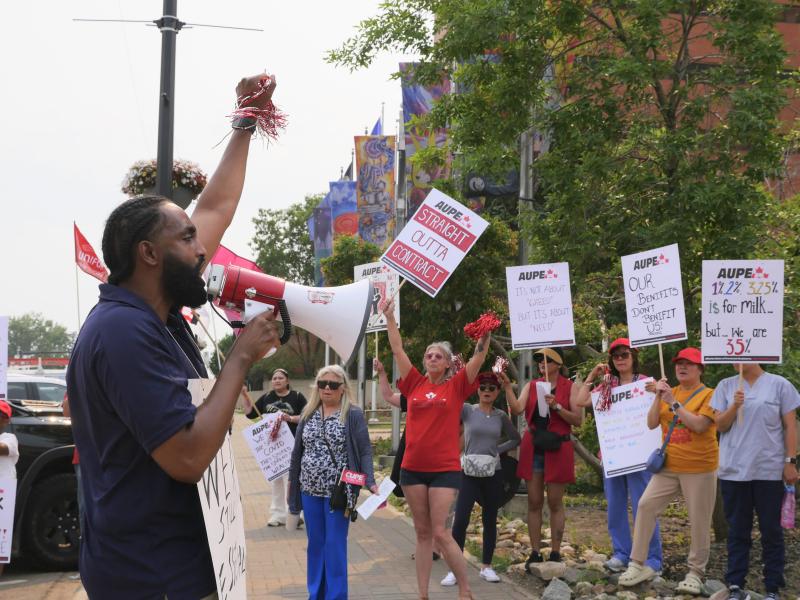By Tamara Aschenbrenner, Communications Staff
Jumping into an extremely hot bath right away can be overwhelming and uncomfortable. However, if you start with warm water and gradually add hot water, you become comfortable and can fully relax and enjoy it.
The same approach works with organizing union action. You want to start small and then ease in to something big.
“Organizing isn’t a one-size-fits-all process. It builds intensity over time. The essential thing is having conversations with our coworkers, then we move to awareness campaigns, then huge rallies and, if necessary, strikes.”
“AUPE members are organizing like never before,” says AUPE President Guy Smith. “Importantly, we started with wearing red at the worksite—something simple that tests the waters. Now it is time to work together on stronger, bigger actions.”
Do you feel it? As we do more and our actions grow, so does our confidence. We must be ready for when things get more intense. That is how we build solidarity, step-by-step. We must get used to organizing large, loud actions by the time a strike is necessary.
“Organizing isn’t a one-size-fits-all process,” says Smith. “It builds intensity over time. The essential thing is having conversations with our coworkers, then we move to awareness campaigns, then huge rallies and, if necessary, strikes.”
Let’s go over some of the steps AUPE members are taking right now to deal with problems they are facing at work.
1. Start with in-person conversations
Talk with your coworkers about the big issues. Share information, address your concerns, answer questions, and explain the importance of getting involved in union activities. Personal interactions help build a sense of community and commitment, making it easier to mobilize support for future actions. It’s okay to talk about work at work.

2. Build visibility
Members are wearing a lot of red right now. Wearing red unites us. It’s a huge visual symbol. Doing so raises awareness with non-union members and the public, showing them our cause is worth paying attention to.
Wearing red is easy, so it encourages participation from members who might be hesitant to join more intense actions, making it a great place to start.
Wearing red may seem like a small action, but we’ve already seen waves. Employers are scared, and some have even tried cracking down on dress codes because of our impact. We’ve also amplified our messages beyond the immediate workplaces by sharing photos on social media. The point is as much visible solidarity as possible.
3. Engage and inform
Once members are paying attention, it’s time to inform, engage, and rally support. Town halls and Lunch 'n’ Learns are great events for open dialogue and strategizing. It’s important that we all feel encouraged to voice our concerns, share ideas, and ask questions.
Members held over 50 such town halls across the province. Thousands of members came out to learn more about this historic year of bargaining and how we can fight for better collective agreements. A lot of members also pledged to volunteer for future events, such as our bargaining rallies and info-pickets.

4. Broadcast your support
When you feel that momentum growing, it’s time to bring people together publicly. You want to create a visible sense of unity and show our strength to our employers and the public. Rallies are one way to show our strength, attract media coverage, spread the message to a wider audience, and put pressure on our employers.
AUPE members are using momentum from the Wear Red campaign and June town halls to hold rallies across the province all summer long. The largest rallies will be in Edmonton, Red Deer and Calgary on September 7. It’s all building up to that. Union members, families, and supporters are all invited to participate. Our employers are more likely to take us seriously when we stand together and show our collective power.
5. Organize direct action
Feeling strong? Good. Now it’s time to bring the struggle straight to the shop floor. Taking direct action is a crucial step in workplace organizing, bringing members together to exert visible and unified pressure directly on management. These actions are harder to ignore.
Direct action requires careful planning. Everyone needs to be on the same page and prepared for potential responses from management.
But what kind of action can you plan? A March on the Boss is the most common direct action AUPE member's plan. There are several examples of successful Marches in AUPE’s Members in Action series of articles, including those in this July 2024 edition of Direct Impact.
The important part of any action is that everyone knows the plan, knows the stakes, and knows the goal. To learn more about these kinds of actions, consider taking the Workplace Power course offered through AUPE's Education Department.
6. Prepare for a strike
Strikes are intense. In fact, they are probably the most intense kind of action we can take. They require careful planning and lots of support. Simply put, strikes are only effective if members are resolved to see it through.
Talk to each other about strikes, especially if you have previous experience. Everyone should know what to expect and why it is important to take strike action when we need to.
A good way to get ready for strikes is to hold information pickets. You could even call them ‘practice strikes’ to ensure everyone knows that you are preparing for serious action.

7. Be flexible
The path from symbolic actions to strikes does not move in a straight line. Sometimes you only have to do a few actions until you win your contract or resolve an issue and it never gets too intense. Flexibility is essential.
Whether you take action to solve a problem quickly or need to make changes over a long period of time, the important thing is to keep escalating your actions when you need to. If lower-stakes actions don’t get results, it’s time to turn up the heat. On the other hand, if an action like a rally makes your employer give you higher wages, a stronger action like a strike might not be necessary.
It’s good to look at each action not as something that was a success or failure on its own, but how it can help build your confidence and unity moving forward. The more we support each other and stand together, the stronger our actions will be.


